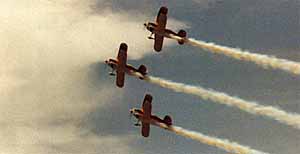
The
Christen Eagles Aerobatic Team pertorms at an airshow |
Barnstorming
was daring, romantic, and showy (and a lot safer than flying
the mail routes), but hardly an economic success. And even
under a dew-covered wing, the ground gets hard after a while.
Many of these gypsy pilots simply decided to settle down
and set up shop in one spot, providing air service for a
single community-which is where the term FBO came from,
for Fixed-Base Operator. An independent few persevered,
still looking for an easy way to make a hard living flying
airplanes.
Flying
circuses were the answer. Even in the beginning, barnstorming
had been mostly a team occupation, simply because it was
nearly impossible for one person to do the flying, work
the crowd, and collect the money simultaneously. The flying
simply began banding together in even larger groups, as
gypsies traditionally have done, and the first traveling
air shows appeared, complete with front men, tickets, and
other dodges borrowed from another uniquely American institution:
the roadshow carnival.
With
these new shows, rides and lessons were no longer the main
attraction. The public proved willing to pay for the scary
and thrilling experience of flight, but as spectators, not
participants. The call was for spectacular deering-do, and
the more nearly impossible and deadly a stunt appeared,
the better. A new era of "display aerobatics" was at hand.
Wing-walking,
air-to-air transfers, and parachutists were the window dressing,
but aerobatics were the stock-in-trade of these early air
shows. New maneuvers began appearing almost weekly, as pilots
competed for reputations and a bigger share of the public
wallet. Point
or Hesitation Rolls were first; big, fat fuselages gave
even the underpowered biplanes of the day good knife-edge
performance. Compound maneuvers, such as the Avalanche,
followed rapidly.
|